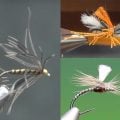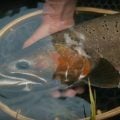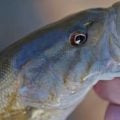Fly Fishing Jazz: Mind The Cadence

Late-season excursion. Photo by Tim Romano
I just returned from an extraordinary fly fishing trip at Lake Athabasca, in northern Saskatchewan. Fishing with Trout Unlimited’s national communications director, Chris Hunt, out of Blackmur’s Athabasca Lodges, we caught more healthy northern pike on the fly than either of us could have imagined. Why more fly fishers do not respect and actively seek the aggressive takes of 40-plus-inch pike is beyond me. Given the choice to go “up north” and run beads for Alaskan rainbows, or have my arms shake and fingers bleed while doing battle with northern pike in Canada… well, the choice isn’t even close anymore.
In the jazz context, I also learned a very valuable lesson during this late-summer pike-a-thon, related to the tempo and timing of stripping streamer flies. Now, the whole point with fishing streamers is to trigger a reaction bite. And that’s true whether you’re fishing for pike, tarpon on the flats, or trout in a river. You want to make the streamer look panicked, as if it’s a baitfish that’s suddenly realized it’s in the wrong place at the wrong time, hopefully within view of the predator you aim to subdue.
It’s important to remember that to catch more fish, your retrieve cannot “march” to the same standard tempo, day after day, fish after fish. You have to mix up, vary your strip cadence, and lock in on what’s working—which might very well change, day by day, hour by hour, even minute by minute.
For example, some of the best permit guides in the Florida Keys will tell you that constant, steady motion is the secret to success. You make the cast, then tuck the rod under your arm, and make even, continuous strips with both hands pulling the line until you feel a take.
On one particular day, that retrieve worked like a charm for northern pike, when the sky was clear, and the wind was calm.
The next day, however, required more of a herky-jerky strip, when it was cloudy and windy.
The next day was rainy, but calm, and then, the pike wouldn’t eat the fly until I let it sink. One long strip (about 18 inches), another long strip, then a short strip, then a pause. They ate it on the pause, but not without the long, attention-grabbing strips beforehand.
Thing is, I’d like to tell you that there are recipes for catching certain fish on certain days, vis a vis how you strip your fly, but I can’t. Because I don’t think those recipes exist.
You have to find the cadence, and understand that it changes, species by species, place by place, on any given day, given the prevailing conditions.
Those who play jazz music just know—and feel—when the notes should be played brightly, in staccato chops, and when they have to linger for effect. You can’t necessarily plan these things ahead of time—they just happen.
The same is true when you’re stripping streamer flies. Mix it up, experiment, and try to feel instead of thinking. And when it works, stick with it. When it stops working, make a change.
The fish want a certain tempo and a certain cadence. It’s up to you to find exactly what that is. Staying in the same beat works sometimes, but not always. The more you make your own beat, the more fish you will catch.











